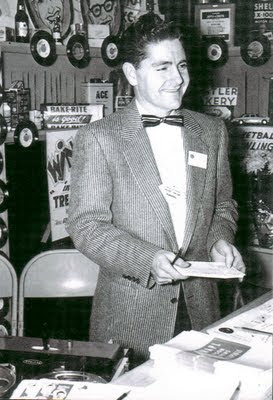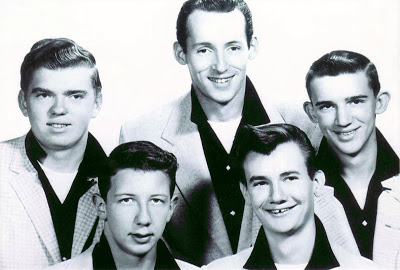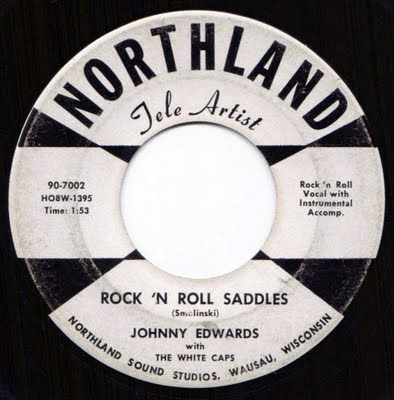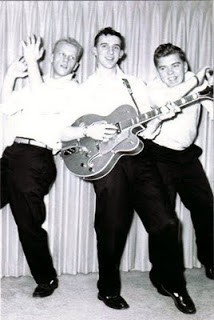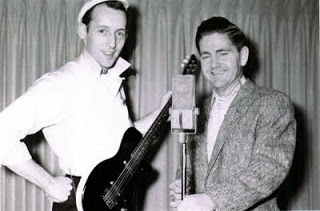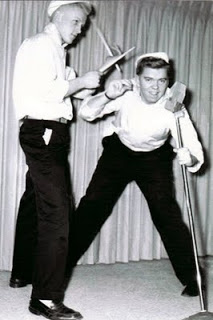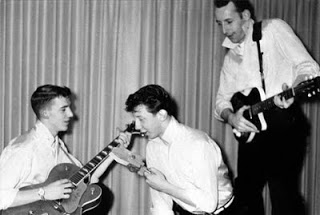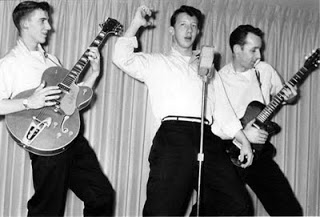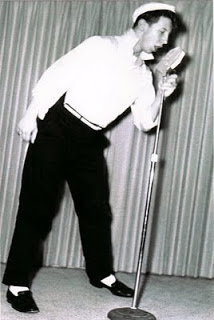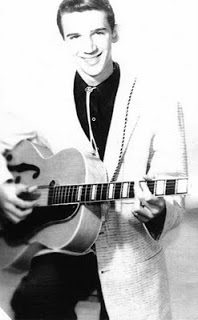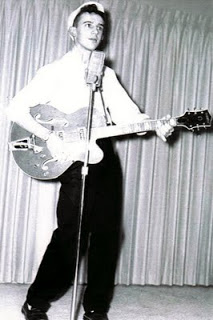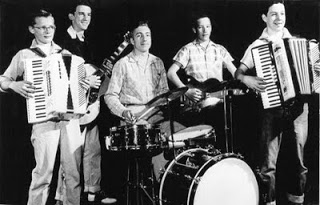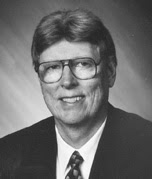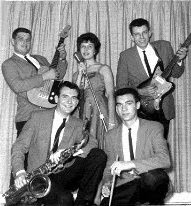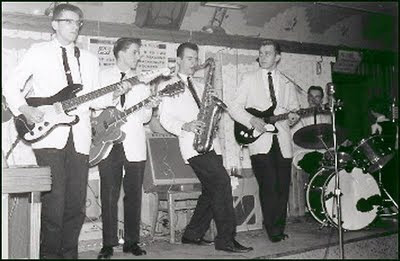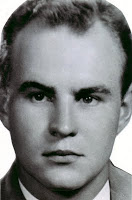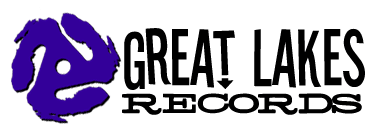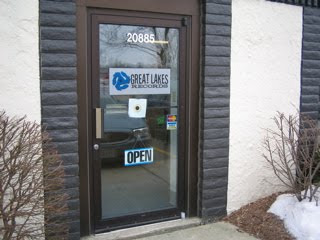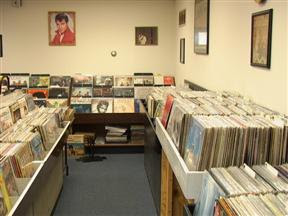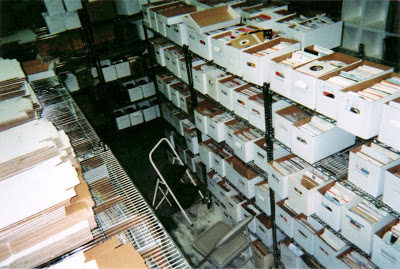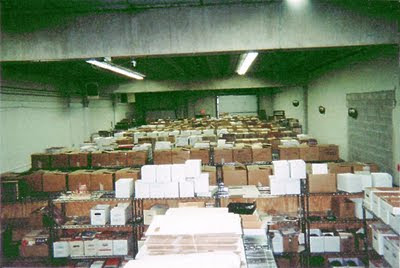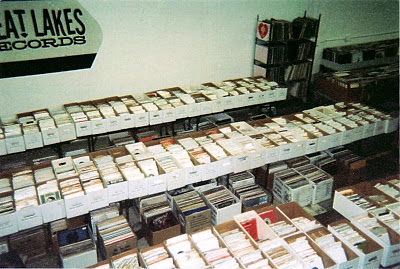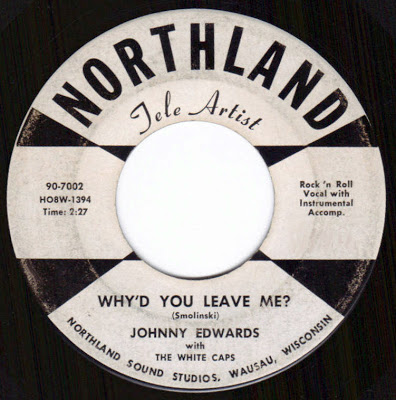Johnny Coy (aka Stan Cook) of WAPL Radio in Appleton circa 1956
Let’s spin our magic radio dial back to 1956 and tune in WAPL in Appleton, Wisconsin. Stan Cook, who’s real name was Johnny Coy, was on the air. His co-workers included Bob Bandy, Smiley Riley (who later moved to WLS in Chicago as Ron Riley), and Jack Gardner. One evening, Johnny Coy was watching a two piece polka band called The Rockin-Rhythm-Airs perform at a local theatre in nearby Neenah, Wisconsin. He felt the group was pretty talented, so he and fellow dee-jay Jack Gardner offered to become the group’s managers. They accepted the offer. Johnny and Jack outfitted every member of the group with a white cap and changed the group’s name to The White Caps, a name that may have been inspired by Gene Vincent’s Blue Caps. Johnny started booking the White Caps into several local clubs, such as the Riverside Ballroom in Green Bay, the Cinderella Ballroom in Appleton, the Eagles Ballroom in Oshkosh, along with various other clubs and schools around Wisconsin. He even got them a gig at The Prom, which was all the way across the state and into Minnesota (Minneapolis).
This is the original lineup of Johnny Edwards With The White Caps. From left to right: Jerry Stengl, Johnny Edwards, Jack Gardner, Jerry (Gerald) Van Dynhoven, and Ricky Leigh (Ricky Lee Smolinski). Gerald became known later as Jerry Williams.
Founding member Gerald Van Dynhoven recalls, “We were playing before Rock ‘n’ Roll started. I was still in high school and we played at weddings, churches and school dances.” The release of Rock Around The Clock by Bill Haley And The Comets changed everything. “We switched to rock, started looking for more musicians and changed our name to The Rockin-Rhythm-Airs,” Williams said. “We knew this new sound was going to be something.”
In January 1957, the group assembled at Northland Sound Studios at 531 Third Street in Wausau, Wisconsin. This was the home of Northland Records, a label run by Duke Wright. The White Caps recorded two songs in that session to be published on their first 45 RPM single. The songs were Rock ‘N Roll Saddles and Why’d You Leave Me? Both had been written by Ricky Lee, the guitar player. This record has come to be known by collectors as the very first “rock and roll” record ever made in Wisconsin.
It’s not clear exactly how many pressings were made of this record, but the number is not very large. The first 500 were made with a white label and listed the artist as simply The Whitecaps. Another 500 were pressed, again on the white label, but with the artist credits changed to Johnny Edwards With The White Caps. The white label started to scorch, so they changed to a maroon label and made around 2000 more copies using both variations of the artist name.
The record got quite a bit of airplay around Wisconsin, but it never caught on nationally. They did manage to get the record played on TV’s American Bandstand in one of that show’s famous song rating segments.
The White Caps disbanded around 1959. Some members went on to play successfully with other groups, while others left the music business and moved on to other ventures.
Ricky Lee (also spelled Rick Leigh sometimes), born Richard Lee Smolinski, was a fantastic guitar player who, at the age of 15, was already showing his guitar teacher how to play! He was just 17 when he wrote these two songs for the White Caps and played lead guitar on the record. Rick continued playing as a member of various groups in the Appleton area for a while. He received a masters degree from Lawrence College, retired from the music scene, and is now working as a computer programmer in Green Bay. Rick’s son is a also musician and, as his proud father says, “He is better than I ever was.”
Pete Miller replaced Gerald Van Dynhoven on the drums and stayed with the White Caps for one year. He moved on to work with Jerry Williams And The Rockets for a while.
Dave Pozolinski replaced Pete on the drums, and he’s still living in the Appleton area. He had been playing drums with a polka combo called The Jitterbugs in Menasha, Wisconsin (above photo). That group also included Ricky Lee Smolinski on lead guitar. Bob Timmers, while still a junior in high school, had also been a member of The Jitterbugs.
Jerry Stengl played piano and accordion. We don’t know where Jerry ended up after leaving the White Caps.
Jack Gardner, the dee jay who co-managed the group with Johnny Coy, ended up playing rhythm guitar for the band. He is currently living in Florida and may still be working in the radio business.
Johnny Edwards, who sang lead and played the saxophone, tragically passed away at a very young age due to a heart attack.
Duke Wright, who was the leader of a polka band and owner of Northland Records, filled in on bass guitar during the recording session. He always joined the group whenever they played around the Wausau area. As the owner of Midwest Communications in Green Bay, Duke has been operating many successful radio stations in Wisconsin, Michigan, Minnesota, Nebraska and Iowa. He started his radio career in 1958 as a teenage disk jockey at WRIG-AM, a station his family owned in Wausau, Wisconsin. After graduating from the University of Wisconsin-Madison, he returned to manage WRIG-AM. He put WRIG-FM on the air in 1964. This was the beginning of a radio broadcasting career that has spanned over 40 years. He served on the Board of Directors of the Wisconsin Broadcasters Association from 1981 to 1985, and was chairman of that group’s Hall of Fame Committee in 1997-1998. He also served on the Board of Directors of the Wisconsin Broadcasters Association Foundation. By the way, all of Duke’s radio stations use MusicMaster to schedule their music! (Thanks, Duke!)
Johnny Coy, the group’s manager, left the radio business and became head of security for the Presto Corporation in Appleton, Wisconsin. He was a very humble man who got a twinkle in his eye whenever he recalled his contribution to Rock and Roll in Wisconsin! He was always held in very high regard by the members of the White Caps. Unfortunately, he passed away in 2004 at the age of 84.
Meanwhile, Jerry (Gerald) Van Dynhoven, who had been the drummer for Rhythmaires And The Rockets, left the White Caps the day before the Northland recording session to form his own band called The Rockets. In the above photo we see the founding members (top row, left to right) Roger Loos (sax) and Jerry Williams (drums), and (lower row left to right) Cliff Peronto (lead guitar), Denny Noie (vocals, rhythm guitar), Larry Russell (vocals, rhythm guitar), and Bill Pable (piano). Jerry was not happy with the way WAPL radio in Appleton was handling the White Caps. He said, “They were really throwing the shaft to us because we were all young kids. Like we were making $60 when they made $1000. So, I broke away!”
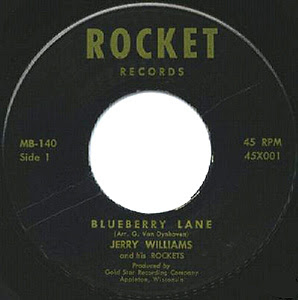
In 1958, the band regrouped under the name The Rockets and started performing across Wisconsin. Jerry Van Dynhoven added his first and middle name to dub the band Jerry Williams And The Rockets. Later Jerry’s brother Donnie joined the band and began using Williams as his last name. Jerry Williams started out playing drums, but switched to sax and guitar later on. Other members that contributed their talents later included: Jerry Starr, Tom Gebheim, Gary Laabs, Ricky Leigh, Dave Hermsen, Jim Kobs, Dave Yokeum, Pete Miller, Brother Don Van Dynhoven, Dennis Heimerman, Bobby “Bryll” Timmers, and Mike Pluger. The group backed Danny And The Juniors at the Cinderella Ballroom in Appleton on March 16, 1958. They also appeared with Fabian in March 1959 at the Riverside Ballroom in Green Bay. They also backed up other bands like Johnny Cash at the Eagles Club in Oshkosh, and Johnny And The Hurricanes at the Riverside Ballroom.
Carol Bosman started out singing at night clubs with her mother who played guitar and her uncle who played the accordion. Many people compared her to Brenda Lee. She was chosen to become the band’s new vocalist after beating out 15 male competitors in auditions. Carol said, “They needed a novelty to top Noie, since Noie left for the military service, and that is why they needed a replacement and brought a girl into the group.” She added, “No other band had ever done that, and it became an attraction.” Apparently, she was also an attraction to Jerry Williams, and she became attracted to Jerry as well. About six months after joining the group, the two started dating. They ended up getting married to each other in 1961, after which she also started using the last name of Williams! Denny Noie later formed his own group, Denny Noie And The In Crowd, and then worked with the Catalinas, while band-mate Roger Loos ended up working with a Wisconsin rock group called The Temptations.
Jerry eventually got over his early troubles with WAPL, later letting a station dee-jay named Bob Falkner produce his group’s only record. which they recorded on January 6, 1962 at the WAPL studios. It was produced by the Gold Star Recording Company in Appleton and released in June 1962 on Rocket 001 (above) and featured an instrumental cover of Blueberry Hill (called Blueberry Lane) on one side, with A Boy Like You, sung by Jerry’s wife Carol (formerly Carol Bosman), on the other side. A Boy Like You was a female “answer” cover version of a Gary Stites song from 1959 called A Girl Like You.
Jerry Williams And The Rockets were in head-to-head competition with the White Caps. According to Bob Timmers, who later joined Johnny And The Rockets playing bass guitar, “The White Caps just stood there and played. The Rockets had uniforms, we had Chuck Berry Stuff, we were flying all over the stage, we were doing the showman stuff, so the band was a little more popular.” The photo of Jerry Williams And The Rockets shown above was taken in 1961. That’s Jerry Williams on the front row left with the sax in his hand. Right next to him is his brother, Donnie Williams (Van Dynhoven), who played drums at this point. In the back row we can see Dennis Heimermann with his bass guitar on the left, Jerry’s wife Carol Williams (Van Dynhoven), and Bob Timmers with his rhythm guitar on the right.
The band played at Catholic Youth Organization (CYO) dances, school functions, weddings and night clubs. According to Jerry, it was the Wednesday evening Pierce Park dances in the late ’50’s and early ’60’s where the group attained its popularity peak. “Because we were all the same ages as the people out there and playing the kind of music that they liked, we were very popular with the crowds,” Jerry said. They won a “best band” contest in Green Bay in 1962. In 1964, when Beatle-Mania hit the country, they continued performing, adopting the sound of the Fab Four.
Here’s another photo of the band with Bob Timmers on the far left. Bob was (and still is) a huge fan of guitarist Johnny Meeks of Gene Vincent’s Blue Caps. He went on to work with many other rock bands in Wisconsin. He did some British Invasion style music with an actual Brit, Lord Beverly Moss And The Mossmen. Bob’s father was the founder of The Bargain Bulletin, a shopping tabloid that still exists today. He worked in the family business for many years, all the while staying tuned in to the music scene. One day he visited the Rock And Roll Hall Of Fame in Cleveland where he was disappointed at the lack of early rock and roll and rockabilly displays. He started talking about starting up a Rockabilly Hall Of Fame. With the help of Joe Wajgel, the Rockabilly Hall Of Fame became a reality on March 21, 1997. On June 5, 2000, Bob moved from Wisconsin to Nashville to set up the Rockabilly Hall Of Fame office there. He’s living in Tennessee now.
Johnny Williams And The Rockets went into retirement in 1979, but got together again to perform at the Pierce Park Apple Sock dances revival in 1990-1994.
Much of the information and photographs in this post came from my friend, Bill Broege. Bill worked as a representative for Columbia/Epic Records for 34 years. Bill had been a close friend of Johnny Coy since they first met in 1957. You will still find Bill selling records at an eight foot table at the vinyl record collector’s shows in Milwaukee that take place at Serb Hall on the south side every month or so. Another valuable source of information was Gary E. Myers great book about Wisconsin bands called Do You Hear That Beat, and his follow up book, On That Wisconsin Beat. I also found pieces of the puzzle at the Rockabilly Hall Of Fame website.
[June 2018 Note: Sadly, my good friend Bill Broege has passed away since this post was first published.]
If you have any more information about these guys, or you were a former member of the White Caps, Jitterbugs, Rockets, or any other associated group, I’d love to hear from you! Please send me an e-mail by clicking HERE. Now, let me tell you a story about how I managed to get my hands on a copy of this historic record!
Back in April 2003, I bought Great Lakes Music at 78th and Burleigh Streets on the north side of Milwaukee. The previous owner, Doug, had been very sick and the shop had been closed up for about a year. I tracked him down, found out the store was in his brother Dave’s name, so I purchased the contents from him. The old store was stuffed full of used records and collectables that filled four very large rooms on two floors. Everything was totally disorganized. Some parts of the store were blocked so badly by stacks of boxes and crap that many of the records hadn’t been seen by anyone in many years. I hired a bunch of helpers and we spent a couple of months cleaning it out, sorting the records, and putting them back in on nice shelves and album racks. I merged in a bunch of records from my own collection, and added a few other large collections that I bought from other dealers around the country. The store reopened as Great Lakes Records, one of the best-stocked used record stores in the country. In October, I moved the whole operation to Brookfield, a western suburb of Milwaukee, where I continued to operate it until April 2006 when I sold the inventory to a bunch of guys from New Zealand who operated a chain of stores called Real Groovy Records. Running Great Lakes Records was one of the best experiences of my life!
One day, while the shop was open in Brookfield, a lady walked in with a big cardboard box filled with old records. People used to bring in old records all the time looking to trade them for some cash. Actually, this is the best reason to own a used record shop — especially if you’re a record collector like me! She walked in, set the box down on the floor, and then waited to speak with Gary, who was busy with another customer at the time. Gary Mason practically ran the store for me, especially since I was busy most of the time running my MusicMaster software business. Most of the time, Gary was the guy at the cash register checking out customers. He helped me price records, arrange them on the racks, and keep the racks in the front of the store updated with “good stuff” that had recently arrived for resale. We both liked to go through new arrivals to see what kind of goodies we’d find in there. But, on this particular day, Gary was really busy and I was out of the shop running an errand or something. After a while, the lady got tired of waiting. She told Gary, “I just wanted to drop these off. I don’t want anything for them. I just wanted them to go to a good home!” Gary thanked her and she was on her way. We never got her name.
Before Gary finished up with the customers, I came back to the shop and saw the box of new arrivals. Before I did anything else, I pulled that box up to the counter and began digging through it. Most of the time, people brought in records that had no real value at all. Many were “too new” to be valuable. Some were extremely common, such as Fleetwood Mac’s Rumors, Boston’s first album, Herb Alpert’s Whipped Cream And Other Delights, and so on. We already had way too many of those in stock. Some of them were more scarce, but had very little demand among collectors, like big band reissue albums or lounge stuff like Jackie Gleason’s Orchestra. Some had both factors working against them, such as the Firestone Christmas Albums. We once filled a 40 foot dumpster to the top with overstock of these albums! I think they were given away free at tire stores and gas stations and everybody in the world got one! Sometimes, someone would walk in with a bunch of fairly valuable records, such as the good soul stuff, or a rare variation of a Beatles album. Unfortunately, too often these used records were in terrible condition and too beat up for us to sell. We used to have a box of these “expensive but beat to crap” records sitting up front by the cash register with a sign saying “Free records – Take one!” Some of the records in this box were listed in the price guides for a lot of money, often more than $100 each. Still, very few people ever took one of the records from that box of freebies.
As I started digging through this new batch, I was half expecting to be disappointed as was usually the case. Almost immediately, however, I knew this was going to be a good batch. For starters, the records were in pretty darn good shape. They were all in sleeves, and many of them were in those old 45 single cases that were popular back in the 1950’s and 1960’s. Kids used those little cases to carry their records to a friend’s house for a party or neighborhood sock hop. Even better, I saw that many of the records in this batch were on local Wisconsin labels featuring fairly small, local bands from the 1950’s and early 1960’s. That’s the cream of the crop! Those are always worth a lot more to collectors because they’re very scarce, virtually unknown, and usually quite good. I got about half way through the records in the box and there it was — a nice clean copy of Rock ‘N Roll Saddles by Johnny Edwards With The White Caps on Northland Records! This record is listed in the price guides at about $300 for a clean copy. I showed the record to Gary, who immediately knew what it was (you get to know the rare stuff when you work in the business), and all he could say was, “You lucky dog!”
We both wanted to track down the lady who brought in those records and give her some kind of cash for them, but we had no idea who she was. She never came in the shop again. She was probably just visiting town, maybe cleaning out her parent’s old house or something.
Here are some pictures of the inside of Great Lakes Records, which was actually a huge warehouse filled with used records. In the front was a showroom where you’d find the more expensive records (above photo). Still, with all those records to organize, there were plenty of hidden treasures lurking around in the back!
Saddles, by the way, refer to a type of shoe called Saddle Soles that were really popular back in the 1950’s.
Here are the lyrics to Rock ‘N Roll Saddles, in case you want to sing along!
Well I went to a dance just the other night,
the band they was a-rockin’ to the left an’ the right.
I sure got a shock as I walked in through the door,
I saw the rock roll saddles boppin’ ‘cross the floor.
Well th’ rock ‘n roll saddles, white and black,
the rock ‘n roll saddles with a buckle on the back,
the rock ‘n roll saddles, dancin’ to the rock an’ roll.
Well, the cats they were jumpin’ and goin’ hog wild;
The chicks sure looked cute with their ponytails high.
I really had’a smile when I took a peek,
at the rock ‘n roll saddles on the pretty gals’ feet.
Well’a rock ‘n roll saddles, white and black,
rock ‘n roll saddles with a buckle on the back,
a’rock ‘n roll saddles, a’dancin’ to the rock an’ roll.
All right now, it’s your chance! (guitar break)
Weird man! (guitar break continues)
Well that pretty little girlie came out to me;
She said, “Come on honey won’t ya bop with me?”
I said, “Okay baby,” but I couldn’t keep from starin’
at what that little rock ‘n roll-a mama was a-wearin’.
Well’a rock ‘n roll saddles, white and black,
a’rock ‘n roll saddles with a buckle on the back,
a’rock ‘n roll saddles, boppin’ to the rock an’ roll.
Well’a rock ‘n roll saddles, boppity bop;
a’rock ‘n roll saddles, boppity bop,
a’rock ‘n roll saddles, teach me to da-do the rock ‘n roll.
You can find Rock ‘N ‘Roll Saddles on these compilation CDs:
Buffalo Bop: Rock ‘N Roll Riot (CD 55004)
Pure Rockabilly – Volume 5 (Club LP 005)
Ultra Rare Rockabilly’s – Volume 13 (Chief CD 1156513/2)
Wisconsin Rock-A-Billy (CD)
32 Original Historic Rockabilly Classics – Volume 3 (CD)
And, here’s a recording of that record I got out of the cardboard box, Johnny Edwards With The White Caps doing “Rock ‘N Roll Saddles.” This is the very first rock and roll record ever pressed in Wisconsin, recorded in 1957:
The flip side of that record is pretty good too!
Here’s the rarely heard flip side, Why’d You Leave Me? I actually like this side very much, too! I hope you enjoy it as well:
Here’s Gary Stites doing A Girl Like You from 1959:
Here’s Jerry Williams And The Rockets doing Blueberry Lane from 1962:
Here’s Jerry Williams And The Rockets doing A Boy Like You from 1962:
You’ll hear all of these songs, along with more than a thousand great rock and roll songs from Wisconsin, on MusicMaster Oldies! Thanks for listening! Tell your friends!

